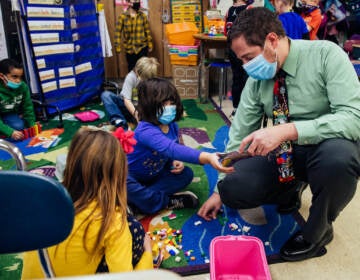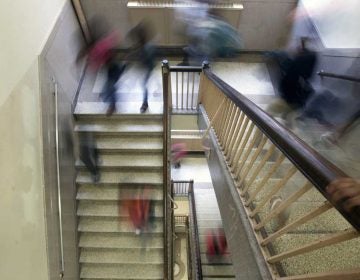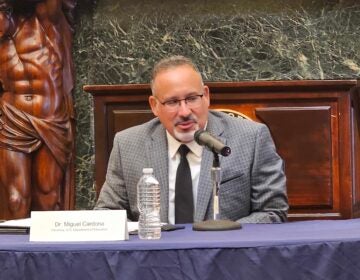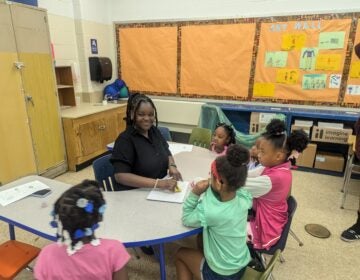A look at the trial — and ruling — that could change Pa.’s school funding system forever
Pennsylvania’s constitution says the legislature has to provide for a “thorough and efficient” system of schools. But what does that really mean?
Listen 32:11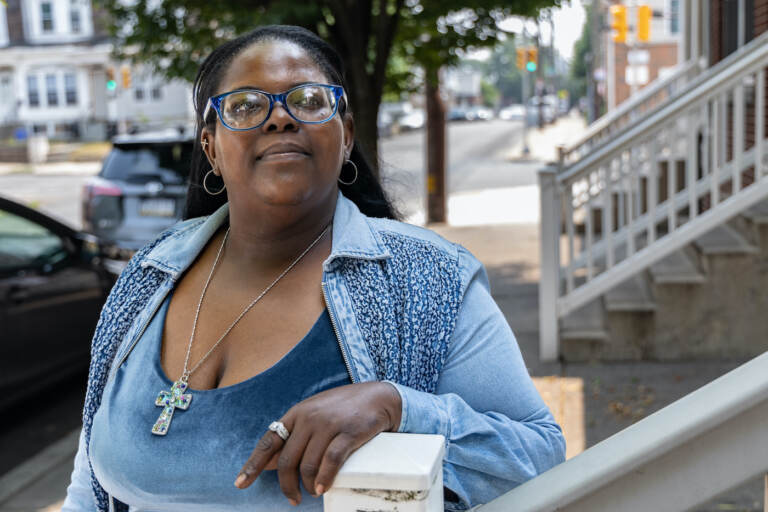
Sheila Armstrong was one of several parents to sue Pennsylvania for more equitable school funding in 2014. (Kimberly Paynter/WHYY)
This episode is the second in this season of “Schooled”, a podcast production from WHYY that gives the insider’s story of public schools, through the eyes of students, parents, and educators.
Read and listen to the first episode.
Find “Schooled” on Apple Podcasts, Spotify, or wherever you get your podcasts.
On the morning of Nov. 12, 2021, hundreds of people rallied at the steps of Pennsylvania’s capitol building to demand more equitable school funding.
Advocates had done this dozens, if not hundreds, of times before, but this day was different.
Right down the street, a landmark lawsuit — decades in the making — was finally being heard in the state’s Commonwealth Court. The distinctive sound of cowbells, which had become a symbol of their fight, could be heard from blocks away.
Sheila Armstrong, one of the plaintiffs in the case, remembers that day well. She still has her bell, which she displays on a shelf in her living room.
“Ring my bell,” she says while shaking it; its clang reverberating.
Sheila was one of several parents who sued the state for more funding in 2014, along with six school districts and two state-wide advocacy groups. They were represented by the Public Interest Law Center, Education Law Center, and the law firm O’Melveny and Myers, which joined the case pro bono.
Throughout the process, Sheila and others would ring these red cowbells at press conferences and outside courtrooms — to remind people what they were fighting for: a system of “thorough and efficient” schools.
The words, “thorough and efficient,” come from the state’s own constitution and ultimately, that language was at the heart of the case.
Pennsylvania’s education clause says the legislature, “shall provide for the maintenance and support of a thorough and efficient system of public education to serve the needs of the Commonwealth.”
So essentially, the legislature has to pay for public education. The question is: what do they have to pay for exactly, and what does “thorough and efficient” really mean?
Plaintiffs argued the state had violated its constitution by failing to provide all schools with enough money to fully function. They said the main problem is that school funding relies heavily on local property taxes.
In Pennsylvania, this has resulted in wide spending gaps between school districts in rich and poor areas. Some have more than enough wealth (think suburban enclaves with mansions) to raise money beyond what they need, while others can barely afford the basics.
Local dollars are just one source of school funding, since money also comes directly from the state as well as a small portion from the federal government. But when local dollars make up more than half of the funding, like in the commonwealth, the level of inequity it produces can be overwhelming.
This is why some schools in Pennsylvania are state-of-the-art and others are falling apart; why some students learn Mandarin or Latin while others don’t have access to a librarian.
In her opening statement, Katrina Robson, one of the lawyers for the plaintiffs, said the authors of the state’s education clause chose their words carefully.
“They didn’t provide for just any level of education. This wasn’t a check-the-box exercise,” Robson said. “They are words that require more than a bare minimum. Words that require a system that serves all children, not just some. The question before this court is whether the General Assembly has met its mandate. We will show that it has not.”
On the other side, Patrick Northen, a lawyer for one of the state’s defendants, then-GOP House Speaker Bryan Cutler, was also focused on word choice.
He said the authors considered including the word “uniform” in the clause but ultimately did not.
“The framers were also worried about a race to the bottom, meaning that rather than elevating lower-performing schools to do better, a uniformity clause might cause higher-performing schools to weaken their efforts,” Northen said.
He went on to say that “thorough and efficient” means that the state must provide free education to all K-12 students, which it does, and that it doesn’t guarantee anything beyond that.
It would be up to the judge to decide who was right.
Waving the white flag
The architect of the case was Michael Churchill, a lawyer with the Philadelphia-based Public Interest Law Center who had a long history of taking the state to task on issues in public education.
Michael’s goal was to bring together schools from across the state to challenge Pennsylvania’s funding system. Many districts were reluctant to take on Harrisburg, he says, but not William Penn, the underfunded, suburban school system just outside Philadelphia.

Signing onto the case wasn’t an easy proposition, says Jennifer Hoff, who was William Penn’s school board president in the 2010s when Michael was building the case.
“You’re gonna wave the flag and say, ‘Hey we’re poor and things aren’t going great here.’ But we didn’t see any other way,” she says. “We knew that we had to fight for ourselves or it wasn’t gonna happen.”
More than two decades ago, Jennifer got involved in education policy when she moved to Lansdowne, one of six boroughs covered by the William Penn School District. Her oldest child was a toddler then and she was visibly pregnant with twins.
One day she was working in the yard when someone walked up to her and said, ‘‘Welcome to the neighborhood. The schools are really bad.”
She wasn’t phased. Jennifer comes from a family of teachers and says her mom taught in a supposed “bad” school district. But she wanted to know what her new neighbor meant, so she started going to school board meetings.
Jennifer says not much has changed between now and then. The district is still facing the same big issue. It didn’t have enough money, despite having one of the highest property tax rates in the state.
“Nobody likes their property taxes. They’re outrageous,” she says. “But they also understand that the path to their house being worth more money is better schools. So it’s sort of the balance.”
The problem is the houses in this district are not valued as highly as in other areas, so even with the high tax rate, the district doesn’t collect enough money to fully function.
Families who can, often move to wealthier communities because they are perceived as having better schools. And at least from a funding perspective, they often do. This goes back to the state’s reliance on local property taxes to fund education, and it creates a vicious cycle for low-income families as wealth becomes more concentrated.
“There is right and wrong, and no young person should have their education decided by how much their parents make,” Jennifer says.
When her kids were old enough, she enrolled them in William Penn’s schools. They were underfunded, but they were good in other ways. She saw teachers and administrators that cared about their students, and she appreciated the strong sense of community.
A few years after that, she ran for a seat on the school board and won.
From the very beginning, she had one goal: “I always said that I would stay until we got funding,” Jennifer said.
She and the rest of the board believed Pennsylvania’s school funding system was at the root of many of their problems, so they frequently asked their legislators for help. They’d throw them a million here and a million there, but it was far from enough.
“We always knew that the only path forward was another lawsuit,” Jennifer said.
Because of William Penn’s relatively low property value, she knew the system would never work for them. And in trying to keep up, they risked taxing their residents out of their homes.
Weighing these concerns, the district’s school board (with Jennifer at its helm), agreed to serve as the lawsuit’s lead plaintiff.
The suit named state officials including the governor at the time, Tom Corbett, the secretary of education, and leaders of the legislature.
It accused them of violating Pennsylvania’s constitution, which says the state legislature has to provide for the maintenance and support of a “thorough and efficient” system of public schools.
The six districts were located in rural, urban, and suburban communities. They stretched from Greater Johnstown in western Pennsylvania, to Wilkes-Barre in the northeast, and William Penn in the southeast. Some of the districts have mostly white students, while others have mostly students of color.
“Our first job was to … prove that there’s not sufficient funding and that the funding that there is is unfair,” Michael said.

Bringing kindergarten to the courtroom
Michael’s first strategy was to call witnesses who could show how a lack of funding was preventing some schools from providing students with an adequate education.
One of those witnesses was William Penn kindergarten teacher Nicole Miller. Once a student in the district, she has now been teaching there for more than 20 years.
“I left in tears,” she says. “It’s unbelievable what the other side would say.”
Nicole felt like the lawyers for the state were blaming her students for not achieving.
“It sounded like I was hearing that children who have learning gaps or children in districts that look like ours are unmotivated.”
That they don’t want to go to school or their parents don’t value education, she said.
“Not one of my kindergarteners is unmotivated. They want to come to school.”

Nicole says when her students struggle, it’s not because they lack motivation, but because they don’t have the resources they need to succeed.
She says she sees the spark and the love of learning in almost every child when they start. But as they grow older, she sometimes watches that spark die.
“When I talk to them and I get to the root of it, a lot of it is frustration,” she says.
Many of these students require one-on-one attention, Nicole says, but they rarely get it because class sizes are large and teachers don’t have enough time.
Nicole’s classroom is welcoming. It’s the kind of place where kids want to come and learn. The walls are covered with student artwork, and butterflies and kites for springtime.
One wall has a poster where Nicole has written down her students’ goals for the year, including the big one, ‘learn to read,’ along with her classroom rules like, ‘always be kind.’

While the room is clean and colorful, it’s also worn and a little empty.
The tiny tables students sit at are rickety, faded, and need to be replaced. Very little in the classroom has been upgraded during the two decades she’s been teaching. In fact, she says the school is largely unchanged from when she was a student at Evans in the 1980s.
In a typical year, Nicole has about 25 students in her class. Many of them don’t attend preschool. And most live in poverty, which research says makes them less likely to build important early literacy skills at home.
So when they start the school year, some students may have started reading sight words, while others don’t know the difference between a number, a letter, and a shape.
She sometimes thinks about what it would be like if all of her students attended high-quality preschool.
“That is actually my dream,” she says. “Imagine what you could do with a whole year. Two years of high-quality preschool instruction. It would make all the difference in the world.”
Pennsylvania has some free preschool options, but there are not enough spots, and it isn’t all high-quality. So Nicole meets kids where they’re at and tries her best to get them ready for first grade.
By the end of kindergarten, she wants everyone to be a reader, a writer, and to feel successful.
“I want them to feel like they love to come to school, they love to learn.”

But getting students the support they need can be difficult when she’s the only adult in the room.
For example, during the day’s reading block, Nicole likes to have students work in small groups. Not only is it good for them, but it’s something her school’s curriculum explicitly instructs. It also frees her up to work with kids who need extra help.
While she works with a student one-on-one, the other students are expected to work independently. But they’re just kindergartners.
“They’re 5,” Nicole says. “So they’re not ready to be independent learners.”
While Nicole tries to help a student, other children wait to show her the sentences they’ve written. She doesn’t think the boy, who joined her class a few weeks ago, has spent much time in school. While the other children form basic sentences, he can barely write his name.
Nicole asks him what he wants to say and writes it for him in his notebook. She uses a highlighter so he can trace the letters. Then she lets him draw a picture to match so he feels successful.

In the middle of all this, a student who is clearly not a kindergartener walks into Nicole’s classroom holding a pink slip of paper.
The fifth-grader has been sent out of his class for misbehavior, to Nicole, who is one of the school’s two lead teachers.
As Nicole tries to get to the bottom of what happened, she keeps working with her new student, while also keeping an eye on everything else that’s happening in her classroom.
This level of multitasking is both impressive and troubling.
Nicole says the school’s one counselor is often busy. The same is true for the principal, so she steps in to help. But she doesn’t feel fully equipped.
“It’s just not my skill set,” she says. “But I try.”
This is the reality in most underfunded schools, not just in Pennsylvania, but across the country. In another plaintiff district, the elementary school principal is the counselor.
When Nicole took the stand, she talked about how increased funding would allow her school to better serve students by hiring more staff.
For example, Nicole says it might take her a few days to notice or correct a student who is struggling since she’s the only adult. That, she says, is how learning gaps form.
At the trial, she felt like her words fell on deaf ears.
“I feel like the other side maybe just doesn’t have a clue. They just really don’t see it. It’s not their lived experience,” she says.

‘You wouldn’t send your kids to my school’
Michael Horvath was the only student who took the stand. And by the time the case finally made it to trial, he was a former student.
He was in the eighth grade when the lawsuit was filed in 2014. His mom Tracey Hughes knew she wanted to be involved, but didn’t realize her son would play such a large role in the case.
“I don’t think he was really very pleased with me,” Tracey says with a laugh.
The two live on the banks of the Susquehanna River in Wilkes-Barre, in northeastern Pennsylvania.
Like all of the plaintiff districts, Wilkes-Barre is property-poor and struggles financially — so much so that in the years after the Great Recession, it took extreme measures to lower its expenses and reduce its growing deficit. It cut art classes and closed libraries, furloughed teachers, and fired support staff.
All of these cuts had consequences for students like Michael. He says he didn’t learn the skills he needed for college.
“I never had to write a research paper in high school where I had to cite references and have in-text citations.”
Michael struggled after high school and says he dropped out of college because he was unprepared. But he felt like lawyers for the state weren’t sympathetic, and they tried to make it seem like it was his fault that he didn’t learn what he needed to in high school. They combed through his grades, test scores, and absences.
“They were able to bring up emails between my mom and teachers like thinking I was worried about only girls and football,” he said. “They were asking me questions as if they never went to high school before.”
“I felt so attacked with some of the questions, I just said to the dude, ‘You wouldn’t send your kid to my school.’”

A defense lawyer asked Michael about an email exchange between his mom and one of his teachers when he was a senior in high school. The teacher said he’d bombed a quiz, hadn’t turned in an assignment, and was using his phone when he should have been paying attention in class. Michael didn’t dispute that.
“Did you have a smartphone at this time?” the lawyer asked.
“Yes,” Michael said.
“And what kind of things did you use your phone for?”
Michael responded, “I’m sure it was stupid kid stuff. I was an immature 16-year-old back then.”
After more questions from the lawyer about whether he texted and what apps he used, Michael said it again.
“I get what you’re saying. I shouldn’t have been on my phone … but like I stated, I was an immature, 16-year-old kid.”
Michael says his level of maturity doesn’t change the fact that his school was falling apart or that the library was closed and he had to share one guidance counselor with 700 other kids.
At 21, he is now working and back in school, trying again for his college diploma.
Looking back, Michael says that while he didn’t understand the importance of the case when it was first filed, he’s glad he took the stand.
“I’m glad that it happened when it did because I believe if I had done it earlier in my life, I wouldn’t have appreciated it,” he says. “It gave me a sense of pride … representing the kids from my area and the kids that go to schools like mine.”
A superintendent’s plea
At the heart of the issue was still the question of what “thorough and efficient” standard of education children are entitled to. Defense lawyer Patrick Northen argued that the state only had to provide the basics.
“I’m not going to stand here and argue that all of the school buildings in all of the school districts are the Taj Mahal, or even that the physical conditions in the poorer districts are the same as what you’ll see in wealthier districts,” Northen said.
He went on to say the evidence would show that the kids in plaintiff districts have the, “basic instrumentalities for an adequate education,” listing things like chairs to sit on, desks or tables to write at, walls and roofs, and working plumbing.
But David McAndrew, superintendent of Panther Valley School District — another plaintiff in the suit, said his schools don’t even have those basics. At the elementary school for example, the roof leaks and 75 kindergarteners share just one toilet.

Panther Valley is a small, rural district in the heart of what used to be Pennsylvania’s coal country.
Plaintiff lawyer Michael Churchill says he knew one of the difficult things superintendents in the case would face were allegations that they were being “two-faced,” for saying one thing in the courtroom about the challenges they were facing and saying something else on graduation day when they were congratulating their students.
Only a small fraction of students who graduated from Panther Valley in 2013 earned a two- or four-year college degree within six years of graduating.
“I don’t believe we’re preparing them for the future,” McAndrew said on the stand, growing increasingly emotional.
“It’s not because we don’t want to. It’s because we don’t have the means to,” he said. “We have kids who want to learn. We have kids who are raising their hand but we can’t get to them. We have kids [who] are looking for help, and we can’t help them as much as we want to.”
His testimony ended with a plea.
“I’m asking the State of Pennsylvania to help us,” he said. “Who else is there to ask?”

The state makes its argument
A key piece of evidence was a costing-out study, commissioned by the legislature, that looked at how much money the state needed to spend in order to fully fund its schools.
That report showed the state would need to increase spending by more than $4.3 billion to close the gap. Out of the state’s 500 school districts, just 30 were spending enough money.
At the trial, lawyers for the plaintiffs called Matthew Kelly, a school finance expert from the Penn State College of Education, to provide an updated estimate. Kelly said his analysis, which relied on the same methodology as the original study, found Pennsylvania schools to be underfunded by $4.6 billion.
“They basically admitted the very problems that we were describing in our lawsuit,” Michael Churchill says.
While some of the state’s lawyers disputed this, others didn’t. The defense included both Republicans and Democrats, including Democrat Tom Wolf, who was governor at the time.
Wolf and his administration initially opposed the suit going to trial, and argued they were doing enough on their own to make school funding more equitable. Later he changed course and asked for the case to move forward.
Michael says it was up to the state to prove schools had enough resources, and therefore enough money.
“It was a chance for the other side to say, ‘Yes, you do.’ But, you know, they had no witness that was able to say that,” he said.
Jason Willis, one of the defense’s expert witnesses, is a director at a California-based education research group, and has advised a number of state and school leaders on finance issues.
“It does matter how much you’re investing in the system. But often it matters as much, if not more, how you are spending those resources that you do have to support those students,” Jason said in a recent interview.
In short, money matters, but what matters more is how schools spend the money they do have. It’s the idea that funding isn’t necessarily the problem, it’s school leadership, bad teachers, or poor spending decisions.
Elected officials in Pennsylvania have made this argument over and over again, including the state’s top-ranking Republican, Rep. Bryan Cutler, who was also named in the lawsuit.
Jason made the argument that the state of Pennsylvania is spending plenty of money on education already.
Pennsylvania does spend more per student than the national average, but the districts argue that spending is distributed unevenly because the wealthiest districts and their spending drive up the overall number.
One defense attorney made arguments that went beyond money and dollars spent per student — arguments that questioned the very role of education.
John Krill repeatedly asked one superintendent why the state’s academic standards mattered for all students.
“What use would a carpenter have for biology,” the lawyer asked. “What use would someone on the McDonald’s career track have for Algebra 1?”
“The question in my mind is, ‘thorough and efficient’ to what end? To serve the needs of the Commonwealth. Lest we forget, the Commonwealth has many needs. There’s a need for retail workers, for people who know how to flip a pizza crust.”
Sheila Armstrong, one of the parent plaintiffs, says she found the comments ignorant.
“To sit there and just go under the assumption that our schools don’t need to be great because we need burger flippers — that’s laughable to me because we need that burger flipper to still raise their family,” Sheila said.
“The people that you’re trying to write off are still a part of our society.”
‘Is this finally our moment?’
Thanksgiving came and went. The holidays passed. Then the new year. After nearly four months, the trial finally came to a close.
It took nearly a year for the decision to come.
And then one cold afternoon in February, it finally came.
Sheila was at the supermarket. She started jumping up and down when she heard the news.
“I was like, ‘We won. It’s over. Oh my God,’” she remembers.

The court made its decision: Pennsylvania’s school funding system was inadequate and inequitable — to the point that it violated the state’s constitution.
“I’m all hype and it was funny because people are all around and this lady says, ‘Well how much did we win?’” says Sheila. “And I said, ‘Oh, it ain’t that type of case.’”
The judge deemed the state’s current system unconstitutional, but she didn’t tell them how to fix it. She didn’t tell them how much money to add, or how to distribute it. That would be left to the state.
In its nearly 800-page ruling, the court said there was “no rational basis” for the funding gaps that existed between low- and high-wealth schools, something the state’s funding system had created.
It also said that the state has an obligation to provide the resources necessary for all students to access a “comprehensive, effective, and contemporary system of public education.”
“The thing that was transformative about this court’s opinion is it said that the Constitution requires you to actually figure out what is needed and provide what is needed,” said Michael Churchill, plaintiffs’ lawyer.
While the court has ruled in the schools’ favor, the fight for fair funding is far from over. Now, it’s up to the state legislature to make things right. “Is this finally our moment,” asks teacher Nicole Miller.
Courts have issued similar rulings in other states, and it’s clear that change doesn’t happen overnight.
New Jersey reached a ruling like Pennsylvania’s, in the 1980s. The ruling and subsequent returns to the court reshaped New Jersey’s public school system, steering millions of dollars to some of the state’s poorest districts. But it took decades.
“You lost two generations of students in that time,” said Jennifer Hoff. “That can’t happen here. It absolutely cannot and I don’t think it will.”
While the trial may be over in Pennsylvania, the real fight is just beginning.
Editor’s note: A previous version of this story stated that Tom Wolf was the governor of Pennsylvania when the school funding lawsuit was filed, not Tom Corbett.

Get daily updates from WHYY News!
WHYY is your source for fact-based, in-depth journalism and information. As a nonprofit organization, we rely on financial support from readers like you. Please give today.



